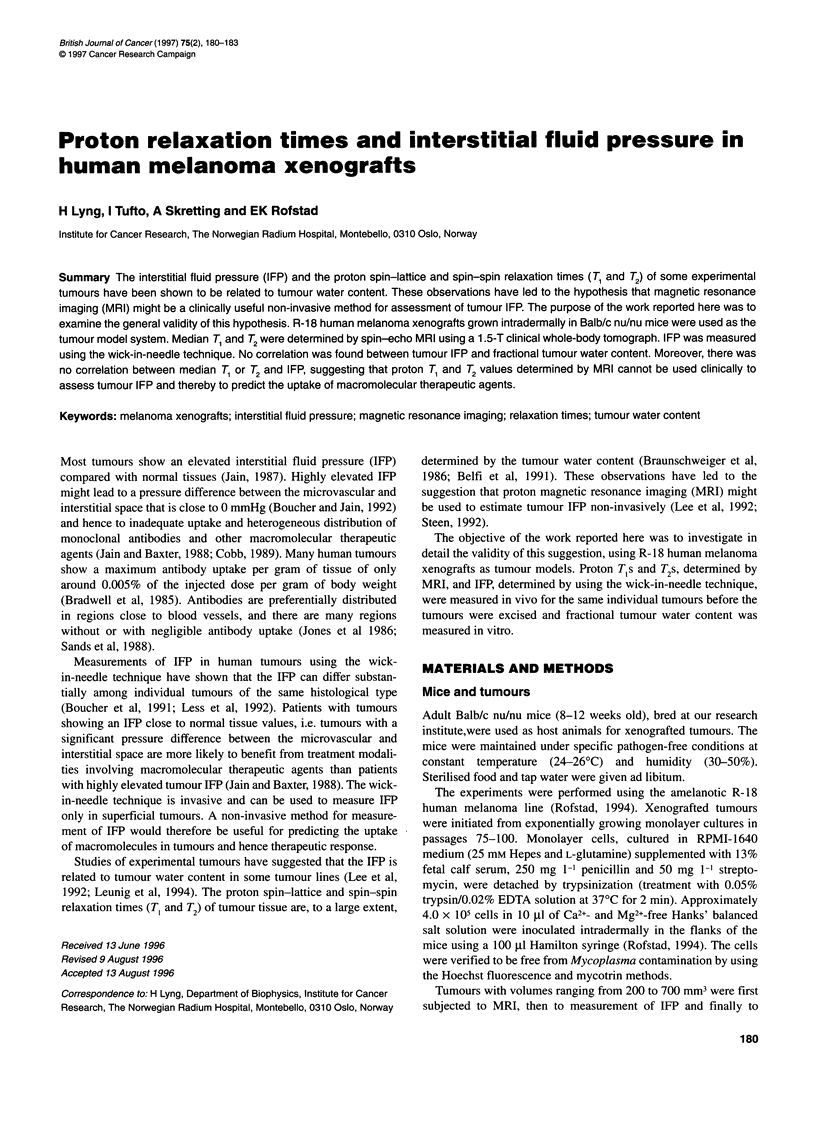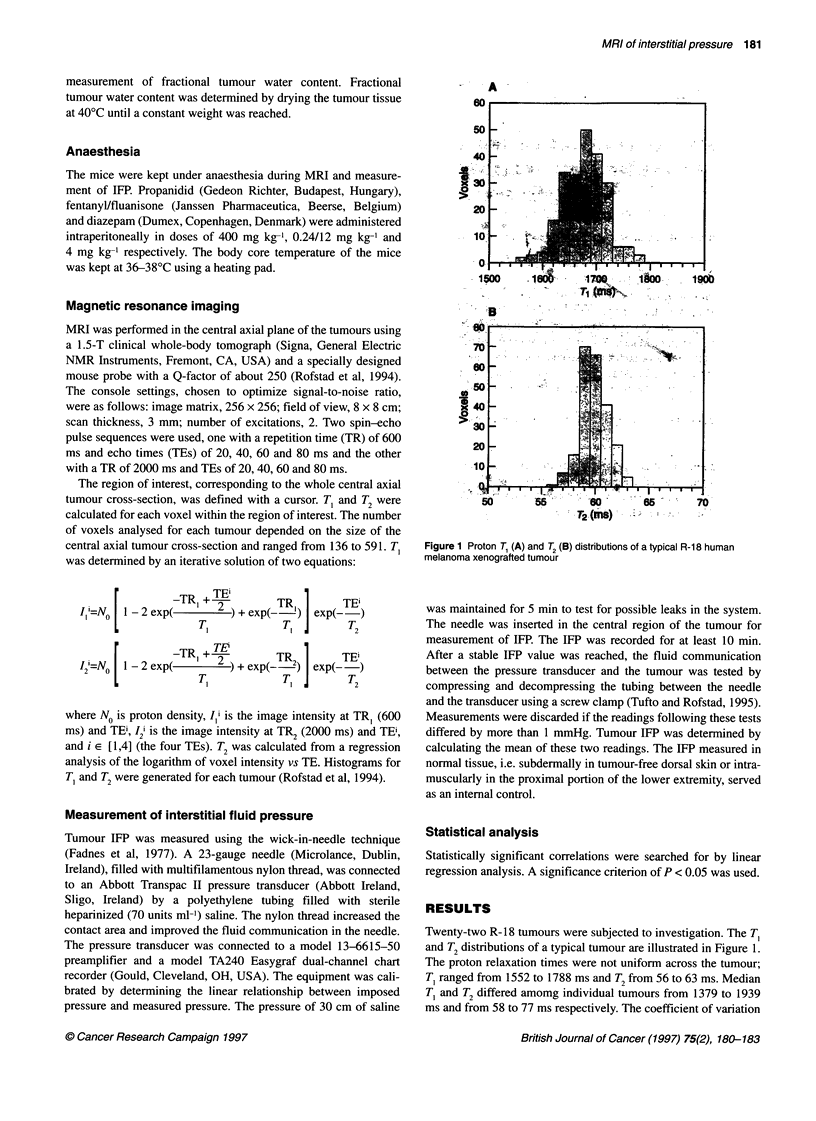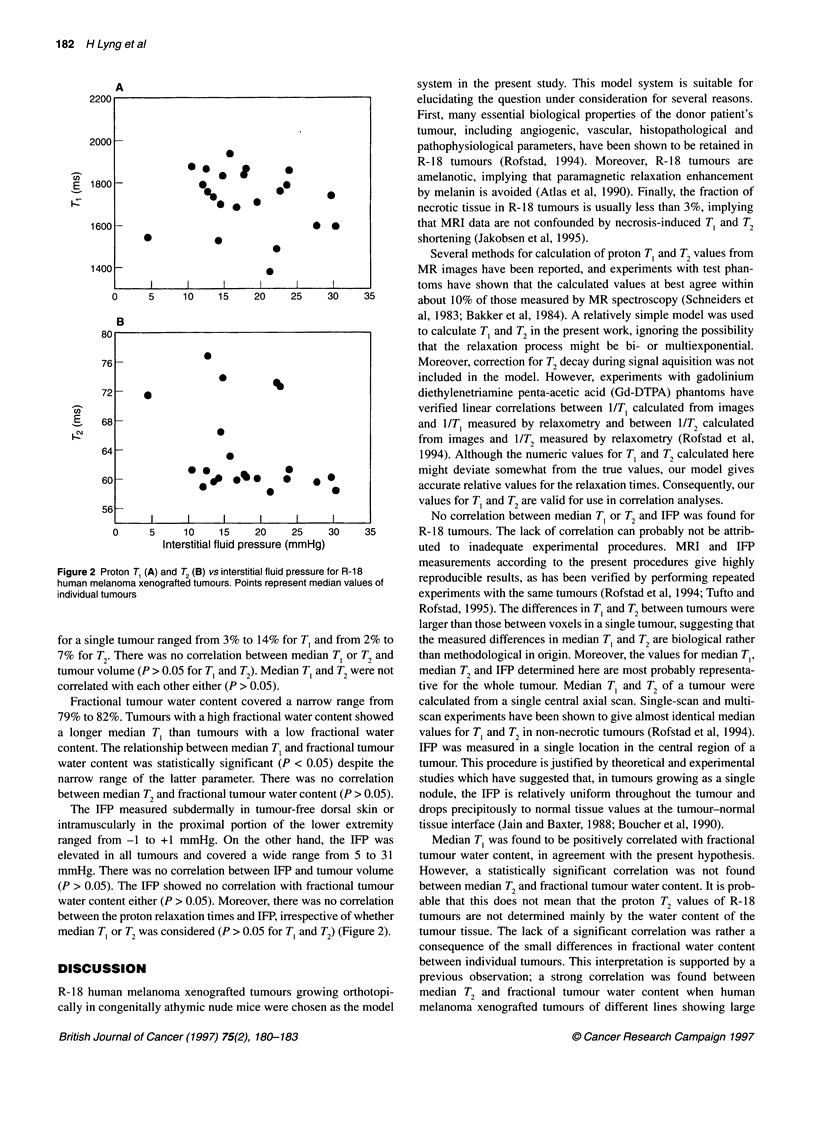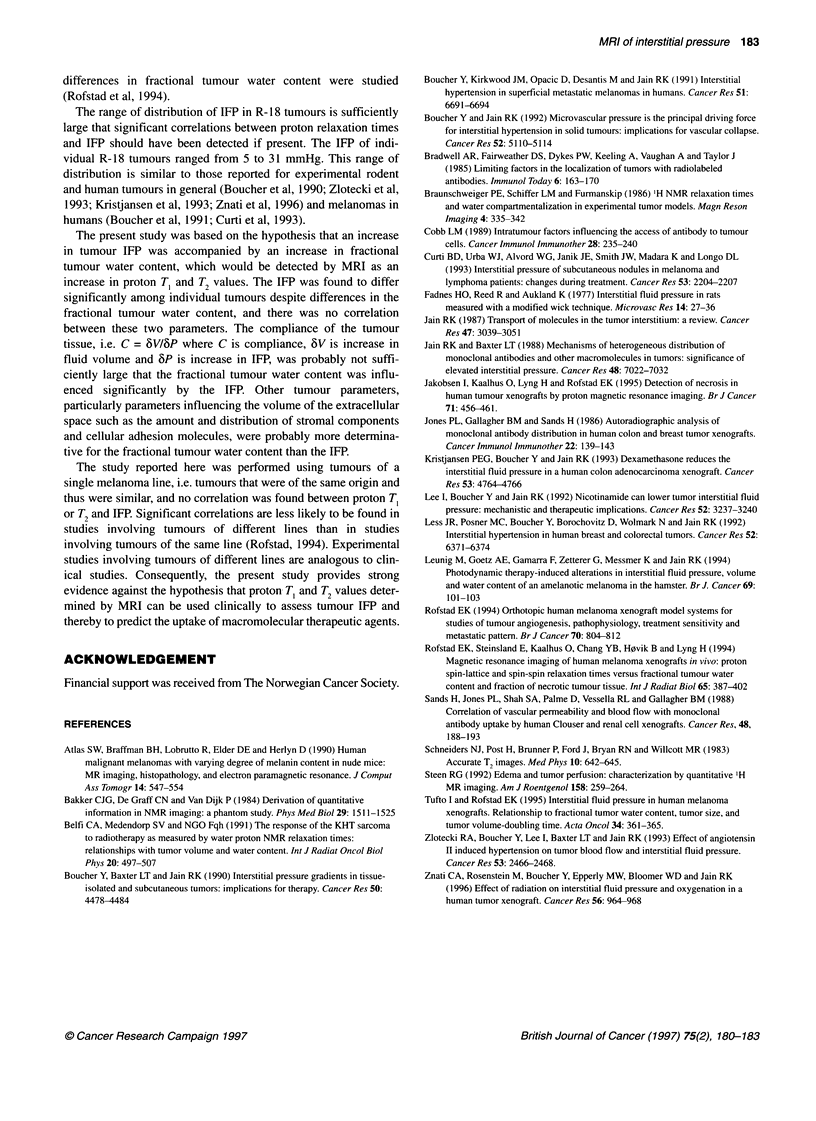Abstract
The interstitial fluid pressure (IFP) and the proton spin-lattice and spin-spin relaxation times (T1 and T2) of some experimental tumours have been shown to be related to tumour water content. These observations have led to the hypothesis that magnetic resonance imaging (MRI) might be a clinically useful non-invasive method for assessment of tumour IFP. The purpose of the work reported here was to examine the general validity of this hypothesis. R-18 human melanoma xenografts grown intradermally in Balb/c nu/nu mice were used as the tumour model system. Median T1 and T2 were determined by spin-echo MRI using a 1.5-T clinical whole-body tomograph. IFP was measured using the wick-in-needle technique. No correlation was found between tumour IFP and fractional tumour water content. Moreover, there was no correlation between median T1 or T2 and IFP, suggesting that proton T1 and T2 values determined by MRI cannot be used clinically to assess tumour IFP and thereby to predict the uptake of macromolecular therapeutic agents.
Full text
PDF



Selected References
These references are in PubMed. This may not be the complete list of references from this article.
- Atlas S. W., Braffman B. H., LoBrutto R., Elder D. E., Herlyn D. Human malignant melanomas with varying degrees of melanin content in nude mice: MR imaging, histopathology, and electron paramagnetic resonance. J Comput Assist Tomogr. 1990 Jul-Aug;14(4):547–554. doi: 10.1097/00004728-199007000-00009. [DOI] [PubMed] [Google Scholar]
- Bakker C. J., de Graaf C. N., van Dijk P. Derivation of quantitative information in NMR imaging: a phantom study. Phys Med Biol. 1984 Dec;29(12):1511–1525. doi: 10.1088/0031-9155/29/12/004. [DOI] [PubMed] [Google Scholar]
- Belfi C. A., Medendorp S. V., Ngo F. Q. The response of the KHT sarcoma to radiotherapy as measured by water proton NMR relaxation times: relationships with tumor volume and water content. Int J Radiat Oncol Biol Phys. 1991 Mar;20(3):497–507. doi: 10.1016/0360-3016(91)90062-9. [DOI] [PubMed] [Google Scholar]
- Boucher Y., Baxter L. T., Jain R. K. Interstitial pressure gradients in tissue-isolated and subcutaneous tumors: implications for therapy. Cancer Res. 1990 Aug 1;50(15):4478–4484. [PubMed] [Google Scholar]
- Boucher Y., Jain R. K. Microvascular pressure is the principal driving force for interstitial hypertension in solid tumors: implications for vascular collapse. Cancer Res. 1992 Sep 15;52(18):5110–5114. [PubMed] [Google Scholar]
- Boucher Y., Kirkwood J. M., Opacic D., Desantis M., Jain R. K. Interstitial hypertension in superficial metastatic melanomas in humans. Cancer Res. 1991 Dec 15;51(24):6691–6694. [PubMed] [Google Scholar]
- Braunschweiger P. G., Schiffer L. M., Furmanski P. 1H-NMR relaxation times and water compartmentalization in experimental tumor models. Magn Reson Imaging. 1986;4(4):335–342. doi: 10.1016/0730-725x(86)91043-x. [DOI] [PubMed] [Google Scholar]
- Cobb L. M. Intratumour factors influencing the access of antibody to tumour cells. Cancer Immunol Immunother. 1989;28(4):235–240. doi: 10.1007/BF00205231. [DOI] [PMC free article] [PubMed] [Google Scholar]
- Curti B. D., Urba W. J., Alvord W. G., Janik J. E., Smith J. W., 2nd, Madara K., Longo D. L. Interstitial pressure of subcutaneous nodules in melanoma and lymphoma patients: changes during treatment. Cancer Res. 1993 May 15;53(10 Suppl):2204–2207. [PubMed] [Google Scholar]
- Fadnes H. O., Reed R. K., Aukland K. Interstitial fluid pressure in rats measured with a modified wick technique. Microvasc Res. 1977 Jul;14(1):27–36. doi: 10.1016/0026-2862(77)90138-8. [DOI] [PubMed] [Google Scholar]
- Jain R. K., Baxter L. T. Mechanisms of heterogeneous distribution of monoclonal antibodies and other macromolecules in tumors: significance of elevated interstitial pressure. Cancer Res. 1988 Dec 15;48(24 Pt 1):7022–7032. [PubMed] [Google Scholar]
- Jain R. K. Transport of molecules in the tumor interstitium: a review. Cancer Res. 1987 Jun 15;47(12):3039–3051. [PubMed] [Google Scholar]
- Jakobsen I., Kaalhus O., Lyng H., Rofstad E. K. Detection of necrosis in human tumour xenografts by proton magnetic resonance imaging. Br J Cancer. 1995 Mar;71(3):456–461. doi: 10.1038/bjc.1995.93. [DOI] [PMC free article] [PubMed] [Google Scholar]
- Jones P. L., Gallagher B. M., Sands H. Autoradiographic analysis of monoclonal antibody distribution in human colon and breast tumor xenografts. Cancer Immunol Immunother. 1986;22(2):139–143. doi: 10.1007/BF00199128. [DOI] [PMC free article] [PubMed] [Google Scholar]
- Kristjansen P. E., Boucher Y., Jain R. K. Dexamethasone reduces the interstitial fluid pressure in a human colon adenocarcinoma xenograft. Cancer Res. 1993 Oct 15;53(20):4764–4766. [PubMed] [Google Scholar]
- Lee I., Boucher Y., Jain R. K. Nicotinamide can lower tumor interstitial fluid pressure: mechanistic and therapeutic implications. Cancer Res. 1992 Jun 1;52(11):3237–3240. [PubMed] [Google Scholar]
- Less J. R., Posner M. C., Boucher Y., Borochovitz D., Wolmark N., Jain R. K. Interstitial hypertension in human breast and colorectal tumors. Cancer Res. 1992 Nov 15;52(22):6371–6374. [PubMed] [Google Scholar]
- Leunig M., Goetz A. E., Gamarra F., Zetterer G., Messmer K., Jain R. K. Photodynamic therapy-induced alterations in interstitial fluid pressure, volume and water content of an amelanotic melanoma in the hamster. Br J Cancer. 1994 Jan;69(1):101–103. doi: 10.1038/bjc.1994.15. [DOI] [PMC free article] [PubMed] [Google Scholar]
- Rofstad E. K. Orthotopic human melanoma xenograft model systems for studies of tumour angiogenesis, pathophysiology, treatment sensitivity and metastatic pattern. Br J Cancer. 1994 Nov;70(5):804–812. doi: 10.1038/bjc.1994.403. [DOI] [PMC free article] [PubMed] [Google Scholar]
- Rofstad E. K., Steinsland E., Kaalhus O., Chang Y. B., Høvik B., Lyng H. Magnetic resonance imaging of human melanoma xenografts in vivo: proton spin-lattice and spin-spin relaxation times versus fractional tumour water content and fraction of necrotic tumour tissue. Int J Radiat Biol. 1994 Mar;65(3):387–401. doi: 10.1080/09553009414550451. [DOI] [PubMed] [Google Scholar]
- Sands H., Jones P. L., Shah S. A., Palme D., Vessella R. L., Gallagher B. M. Correlation of vascular permeability and blood flow with monoclonal antibody uptake by human Clouser and renal cell xenografts. Cancer Res. 1988 Jan 1;48(1):188–193. [PubMed] [Google Scholar]
- Schneiders N. J., Post H., Brunner P., Ford J., Bryan R. N., Willcott M. R. Accurate T2 NMR images. Med Phys. 1983 Sep-Oct;10(5):642–645. doi: 10.1118/1.595368. [DOI] [PubMed] [Google Scholar]
- Steen R. G. Edema and tumor perfusion: characterization by quantitative 1H MR imaging. AJR Am J Roentgenol. 1992 Feb;158(2):259–264. doi: 10.2214/ajr.158.2.1729777. [DOI] [PubMed] [Google Scholar]
- Tufto I., Rofstad E. K. Interstitial fluid pressure in human melanoma xenografts. Relationship to fractional tumor water content, tumor size, and tumor volume-doubling time. Acta Oncol. 1995;34(3):361–365. doi: 10.3109/02841869509093990. [DOI] [PubMed] [Google Scholar]
- Zlotecki R. A., Boucher Y., Lee I., Baxter L. T., Jain R. K. Effect of angiotensin II induced hypertension on tumor blood flow and interstitial fluid pressure. Cancer Res. 1993 Jun 1;53(11):2466–2468. [PubMed] [Google Scholar]
- Znati C. A., Rosenstein M., Boucher Y., Epperly M. W., Bloomer W. D., Jain R. K. Effect of radiation on interstitial fluid pressure and oxygenation in a human tumor xenograft. Cancer Res. 1996 Mar 1;56(5):964–968. [PubMed] [Google Scholar]


